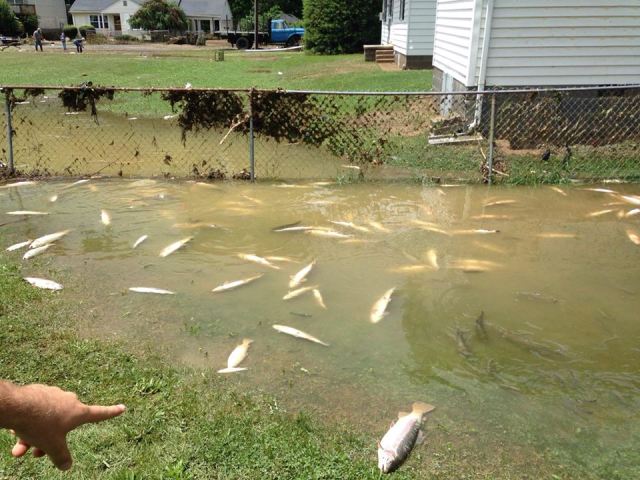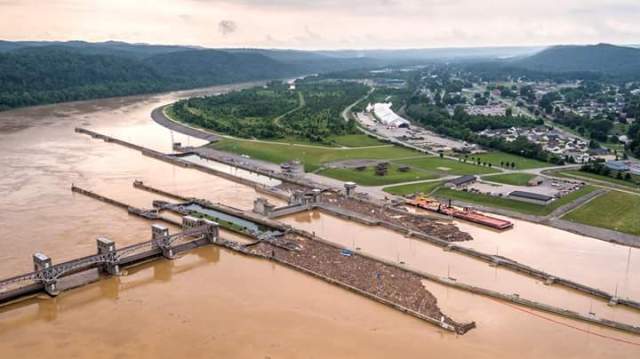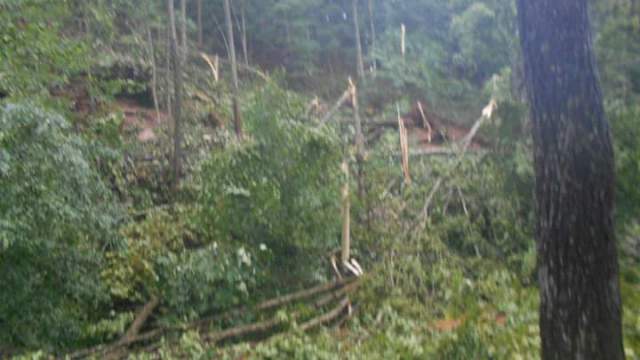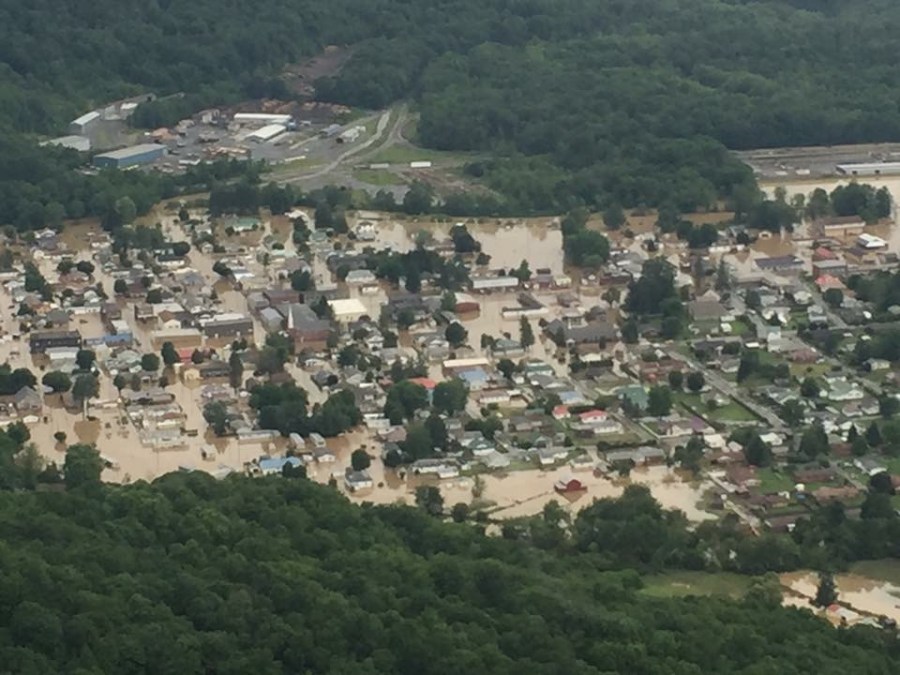Part of the I.C.A.R.U.S. crew has been MIA the last few days. That’s because they have family and friends in Rainelle, West Virginia, in one of the areas directly hit by the “1000 year flood” that struck between Thursday June 23, and Saturday June 25 of 2016. At this time, we still don’t know that all of our friends and family are safe.
What we do know, is that it’s going to be one hell of a clean up, all across the state.
You might not have even heard of the flooding if you’re not in America (many news stations persisted in focusing on Brexit, and did not cover the flooding events as they took place, and are only now beginning to offer stories about them) but I can assure you that it’s been indescribably devastating. I know, you’re thinking “Okay, yeah, but why is I.C.A.R.U.S. writing about it when it’s a humanitarian issue, not a conservation one?”
Here’s the thing, this “1000 year flood” has also devastated, and will continue to devastate, local wildlife populations, and will have an impact on the environment that will be felt for decades into the future. Several indiscriminate assholes have already posted on Facebook pages dedicated to providing information to flood victims, and families of flood victims, about how “West Virginia brought this flooding on themselves with mountaintop mining”.
- West Virginians did nothing to “bring this on themselves”. Most of them have no control over what massive mining companies choose to do.
- Many West Virginians have fought for decades to stop strip mining, and mountaintop removal mining, or MTR.
- Despite that West Virginia is known for coal mining, the towns most affected by this flooding don’t necessarily have anything to do with it. They could be located miles–and counties–away from actual mining sites.
- Anyone commenting with rhetoric on how victims caused their own tragedies, on public forums where people are looking for lost loved ones (human and animal) who were swallowed by floods in the middle of the night, is an asshole.
All of that said, these blame-posters aren’t wrong about the fact that MTR can make flooding worse. Who these commenters need to be blaming, however, are not the victims of the floods, but rather the government entities and agencies who create, and maintain, environmental laws, and regulations in regard to mining.
This has been a struggle that stretches back decades, and one in which success for the people and the environment, has remained elusive.
West Virginia has long been the butt of jokes (in America, anyway) for being filled with inbred hillbillies, who don’t possess enough intelligence to come in out of the rain. The truth, is that the state is filled with, and has produced, some of the most intelligent, self-reliant, and capable humans anywhere in the world. These are not folks who want to be in the middle of an environmental war. In fact, most of the folks in the hollers and vales of West Virginia just want to be left alone by mainstream America, just as the folks of Appalachia have wanted to be left alone since the rest of the world discovered them. There is a long and sordid history of the people of Appalachia being forced from their homes (starting with the tribes of indigenous peoples living there when Europeans arrived and continuing into the 20th century with the forced removal of people from what had been declared National Park lands) and that history includes wars over the plundering of environmental coffers like coal and timber.
Mountain Top Removal Mining, or MTR has been an issue against which most West Virginia, and Appalachian residents have fought. The industry has done little aside from destroying their way of life, and leaving them with a damaged and looted environment.
Through force, or bribe, coal mining companies often skirt what piddly environmental standards or regulations are in place. Never mind their history of killing their own employees for profit. In most recent years, the term “reclamation” has been added to coal mining endeavors, often with the spin that the companies are somehow “reclaiming the environment” after they extract the coal. It’s a lie so thin you could make a window out of it, but it’s one they continue to peddle, and use in order to gain access to land they otherwise would be banned from reaching.
The point is, West Virginians did not cause the 2016 flooding that has destroyed entire communities.
A history of environment abuse–often allowed by government institutions for the benefit of massive conglomerate companies–has systematically damaged the ecology of West Virginia, while impoverishing the communities therein. The misnomer is that West Virginians somehow “want” coal mining, when all they want is a way to make a living. In contrast to public concepts of the issue, West Virginians, and others in Appalachia, are actually the most damaged by the coal mining industry.
But back to the current flooding crisis.
The death toll continues to rise, and people are just now beginning to assess the damage, and begin the recovery process. Something that might be derailed almost before it starts by more incoming storms and rain. In places like the tiny town of Rainelle, population 1500–a place where survivors have reported hearing desperate cries for help from elderly neighbors which eventually stopped one by one as those people drowned in their own homes–as many as 15 people have died, and others remain missing.
So far, news reports have focused on the human impact of the floods, but humans aren’t the only ones suffering. Animals, both domestic and wild, have been ravaged by the floods as well. Animal Friends is one of the groups moving to address the issue of displaced and needful domestic animals. Other private groups, some of them having been born in Rainelle, one of the towns hardest hit by flooding, are raising funds to purchase items for both humans and animals in need.

The environmental impact, has yet to be estimated, or formally reported on by news media. With the state still counting its dead, it would feel caustic to the public for cries of “but what about the environment” to be made. However, images like the ones that follow, are a testament to the very evident and catastrophic damage done on an environmental level.

Trout and other fish swept from the rivers and left to die in yards. Trout fishing is an important, and sustainable industry in West Virginia. But it faces an unknown success this year.





Millions of tons of trash and waste, including chemical and industrial solvents have now been introduced into the watershed by the floods. Safe removal of the garbage could take months, and the damage will last for years. Plastics have long had damaging effects on the environment and been a focus of groups such as The Plastic Pollution Coalition, Plastic Oceans and Plastic Debris Rivers to Sea. Add to the plastic itself, the fact that many of these containers and pieces of garbage will not only remain for hundreds of years, if not removed, but will also leak chemicals, pesticides, poisons and other contaminants into the environment and watershed. Clean water in West Virginia is something that the West Virginia Highlands Conservancy has fought for vehemently. Along with the West Virginia Rivers Coalition they have taken coal mines to task for their pollution of the rivers and waterways. Now both institutions are facing the nearly insurmountable task of cleaning up both millions of tons of debris which includes huge amounts of plastic, and leaking contaminants from both plastic containers, and other storage vessels. The recovery of the watershed, something that has already suffered due to mining pollution, despite the effort of local groups like the Sierra Club, will take years, with lasting effects that will be seen in generations of wildlife in the future.

In places like Rainelle where the above photo was taken, virtually no part of the town was left unscathed. With many residents being elderly, and/or on fixed incomes, and unable to physically help, cleanup will take even longer to accomplish.
While the mainstream media focuses on the horrendous human loss, and devastation, it’s up to groups like I.C.A.R.U.S. to insure that the environmental damage, while no more important than the loss of human life, is also conveyed. Not only have entire communities been demolished but the very face of the mountains and waterways has also been irrevocably changed.







With new storms scheduled to hit the same areas, and places like the Summersville Dam dealing with historic high water, the changes to the environment will undoubtedly continue. At the time of the flooding, water was entering Summersville lake at over 100,000 cubic feet per second, seven times higher than the highest speed possible through the release valves at the bottom of the dam. Should the dam be breeched during future rains, the loss of life for both humans and animals would be inconceivable. All we can do is raise awareness, offer links to information, and pray that Mother Nature gives West Virginia a pass on rain for the next few weeks.
But these tragedies have offered a mirror reflecting the measurable changes caused by human impact through mining, and other industrial endeavors. Endeavors which often profit the few, and malign the many, as is the case in West Virginia right now. This flooding is a wake up call, in some ways, for making positive changes in environmental law which may, in the future, help to assuage flooding that occurs due to natural rain fall.
Resources For West Virginia Flood Information For What’s Going On And How To Help:
Private Relief Effort by Former Citizens devoted to supplying needs for animals and humans alike.


